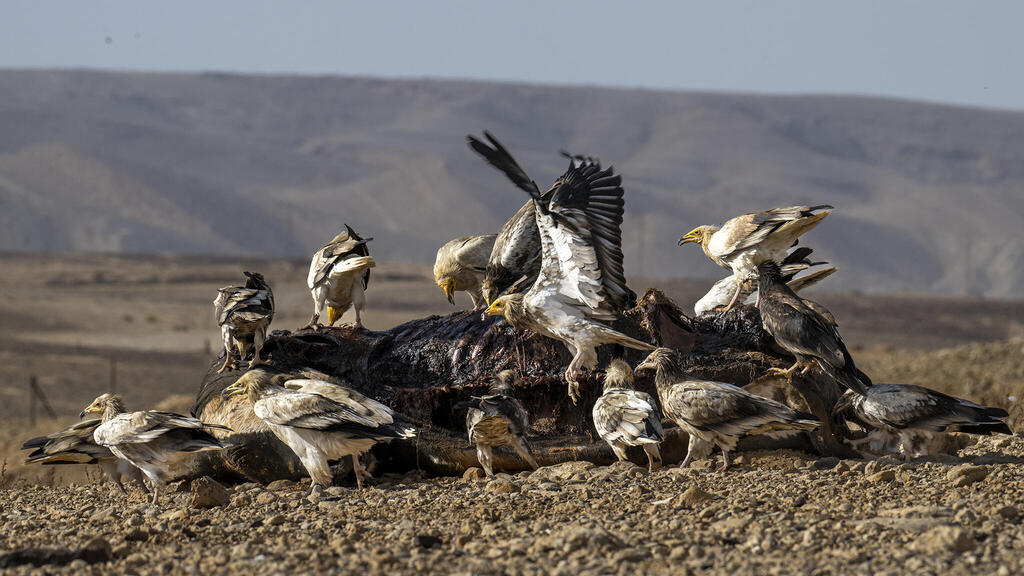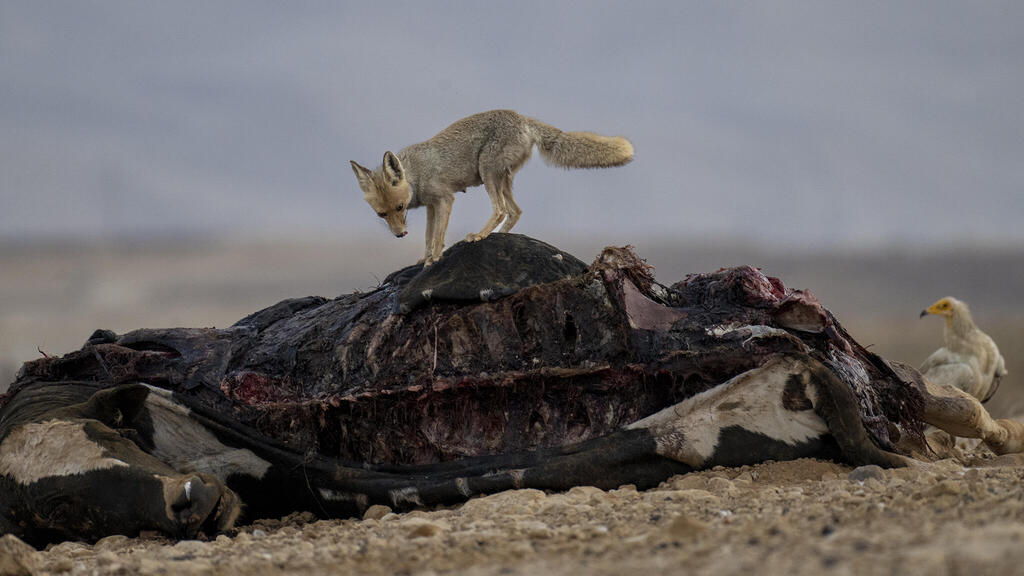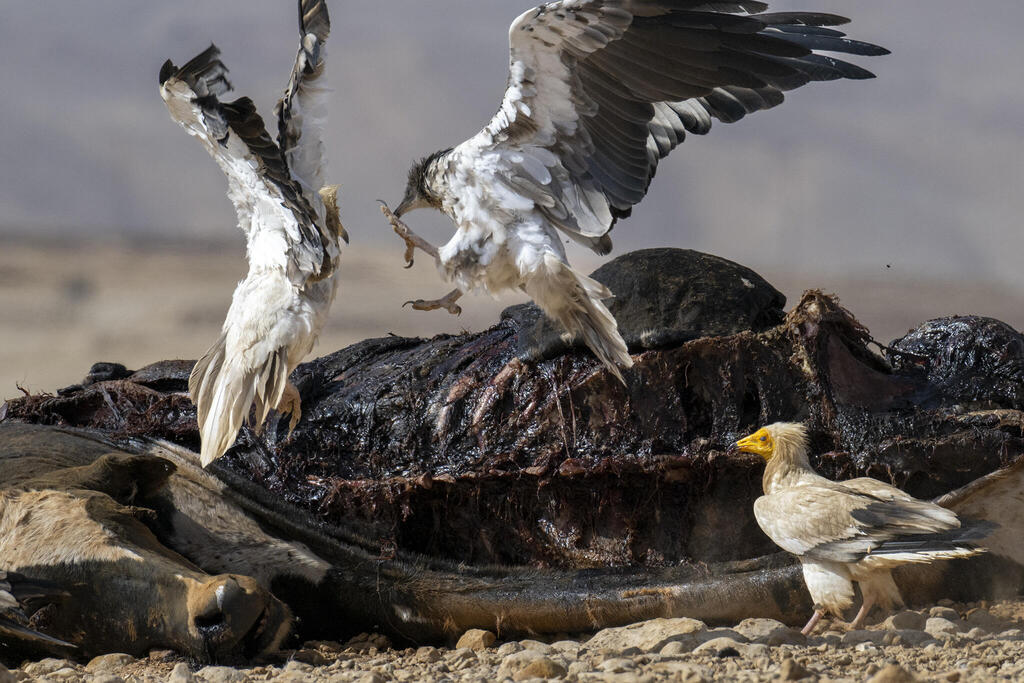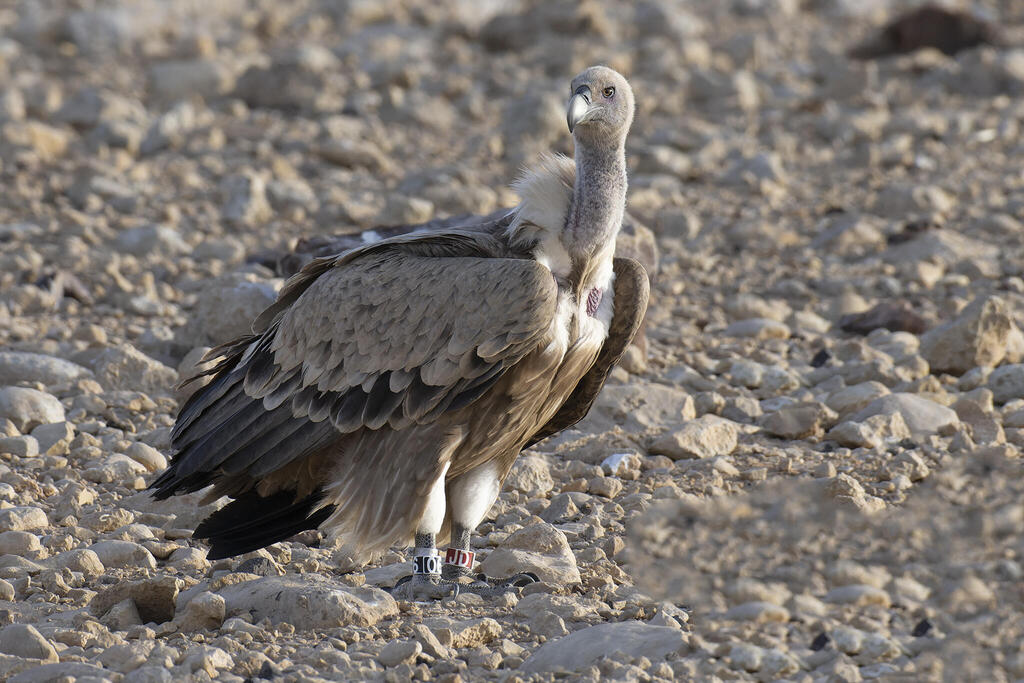Watch: Feeding birds of prey in southern Israel
(Nadav Abbas, Yuval Dex)
Nestled atop a remote peak in the central Negev, a secretive conservation and feeding site serves as a sanctuary for the endangered birds. With approximately 200 vultures remaining in Israel, mostly residing in the Negev, their existence hangs in the balance.
Read more:
Tragic incidents of mass poisonings, claiming the lives of 38 bald vultures in 2021 and 2022, have highlighted the perilous threats they face. Disturbing footage captures the harrowing reality of these incidents. Viewer discretion is advised.
The Nature and Parks Authority, along with the Ministry of Agriculture and the Ministry of Environmental Protection, are undertaking a remarkable endeavor known as "Vulture Mountain." Operating under challenging and sometimes extreme conditions, they diligently collect uncontaminated carcasses across the Negev region. These are then transported in off-road vehicles to provide nourishment for the remaining vultures in southern Israel.
The "Vulture Mountain" project, shrouded in secrecy, captivates nature photographers and wildlife enthusiasts alike. Access to the site is strictly prohibited, except for dedicated Nature and Parks Authority inspectors and trained naturalists, to ensure minimal disturbance to the feeding vultures. The location of this remarkable endeavor remains undisclosed.
As a passionate nature lover, I was granted a rare opportunity to accompany a camera crew and join Asher Peretz, an inspector from the Nature and Parks Authority, on an enthralling journey to witness the feeding of these majestic birds of prey.
Breakfast: Dead calves
In the early morning in the Central Negev, the inspector opens a heavy door, revealing a vast freezer container with dozens of frozen calves that have perished under what is deemed as natural circumstances. A faint scent of decay and decomposing flesh lingers in the air. After I complain about the suffocating smell, Peretz assures me that this is just the beginning.
"In the wild, vultures feed on carcasses, typically calves, cows, horses, donkeys, and camels," he explains. "However, if the vultures were to consume the scattered carcasses in the Negev, they would be exposed to the risk of poisoning."
Why poison the already dead carcasses?
"There are cases where farmers, facing the threat of stray dogs, jackals, wolves, or other wild animals preying on their livestock, resort to poisoning carcasses in an attempt to eliminate the predator harming their herds. Unfortunately, this poses a severe threat to vultures. Another concern arises from farm animals that have been treated with drugs and subsequently died from diseases and antibiotics are toxic to vultures," he says.
"To ensure the vultures have access to safe and nutritious food, we have undertaken a large-scale sanitation project to remove all carcasses from the Negev. We collect suitable carcasses from various dairy farms and farmers, transporting them to secret feeding stations scattered throughout the Negev."
Thawing the meal
A sprawling enclosure sits on a solid concrete surface, concealing a pungent cow carcass in the midst of gradual thawing. Within this space, the odor of decay grows potent, attracting swarms of green flies and giving rise to repulsive fluids seeping in various directions.
Wasting no time, the pragmatic Peretz swiftly employs a crane attached to a rugged four-by-four truck to load the partially thawed carcass, signaling our readiness for the turbulent journey toward Vulture Mountain.
With the commencement of the final leg of our captivating expedition, the truck, equipped with an air conditioning system, proves fortuitous in preventing the ghastly stench from infiltrating our surroundings. Progressing along an asphalt road weaving through the desert, we traverse past Bedouin villages and Jewish settlements.
Upon reaching a covert location, we descend onto the treacherous terrain, embarking on a nightmarish voyage. The awe-inspiring vista of the desert landscape, visible through the vehicle's windows, strikes us with immense force—an expanse of untamed nature and solitude, characterized by deep valleys, towering peaks, and untouched wilderness. As the truck navigates the rough path, jolting and bouncing, the cow carcass, partially frozen, sways, further challenging our journey.
What drives you to do this?
"We must uphold the ideology of preserving the magnificent vulture. We cannot allow the day when we reminisce, saying, 'Once, vultures soared through these lands!'"
Emerging from one of the barren wadis of the desert, the rattling truck starts ascending to greater heights. Every jolt takes a toll on our bodies, and amidst the turbulence, Peretz abruptly halts in front of an enigmatic iron gate. Unlocking the heavy padlock with a proud smile, he declares, "Welcome to Vulture Mountain!"
With unwavering energy, Peretz swiftly leaps from the truck and utilizes the crane to lower the pungent carcass onto its final resting place. Above us, several vulturesand other elusive birds of prey soar majestically in the expansive sky. They know what's coming. I ponder whether the potent and overpowering odor emanating from the thawed carcass, which serves as a delectable treat for them, has reached their keen senses high above. Amused by the peculiar situation, Peretz bursts into laughter. He explains, "Vultures rely on their remarkable eyesight. They can spot a carcass from hundreds of yards away, even from the vastness of the sky."
Why is the location kept secret?
"Picture the scene: as dozens of vultures descend to feast, onlookers become captivated. However, their presence disrupts the vultures in the midst of their meal, causing them to flee in panic, regurgitating their food and leaving hunger in their wake. Expelled from the clean feeding site, the vultures resort to consuming poisoned carcasses elsewhere, leading to dire consequences."
Despite the haunting sight of scattered bones and skulls, the view from Vulture Mountain is breathtaking. As the day draws to a close, Peretz prepares for the journey back to civilization. Yet for avid bird photographer Nadav Abas, the adventure is just beginning. Nestled in the heart of Vulture Mountain lies a modest hideout—an iron cube sunk into the ground.
Before sunrise, Abas, fully equipped with food, water, and toiletries, locks himself inside the hideout, akin to a covert operation in the scorching desert heat. Only later, when the majestic vultures return to their concealed nesting sites in the cliffs, will Peretz release the photographer from his underground refuge.
Vulture Mountain is an extraordinary endeavor. In the name of the vultures, wildlife, and the opportunity for our children to witness these magnificent creatures in the sky, it is a moment to express gratitude to Peretz and the dedicated team at the Nature and Parks Authority for their tireless efforts in sustaining Israel's remaining vulture population.







